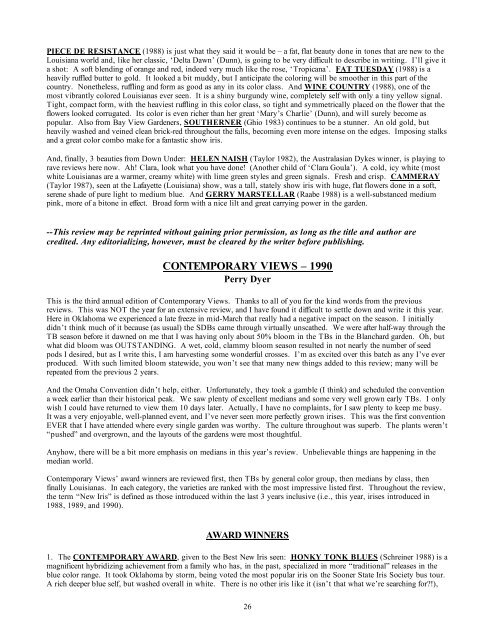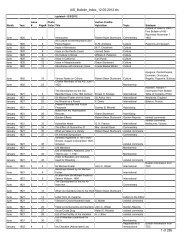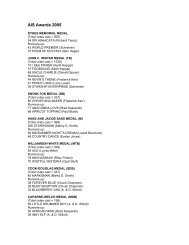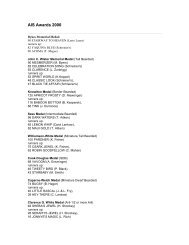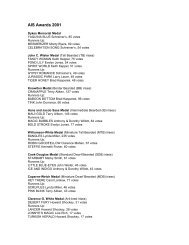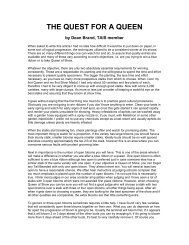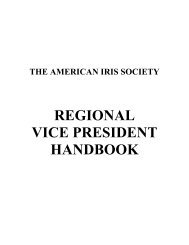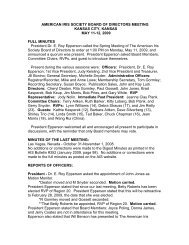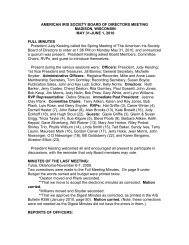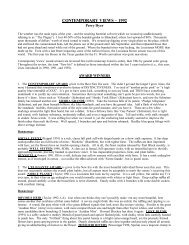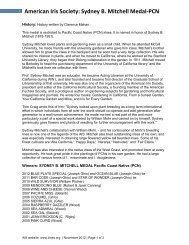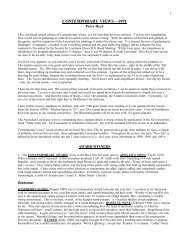contemporary views – 1988 award winners - American Iris Society
contemporary views – 1988 award winners - American Iris Society
contemporary views – 1988 award winners - American Iris Society
You also want an ePaper? Increase the reach of your titles
YUMPU automatically turns print PDFs into web optimized ePapers that Google loves.
PIECE DE RESISTANCE (<strong>1988</strong>) is just what they said it would be <strong>–</strong> a fat, flat beauty done in tones that are new to the<br />
Louisiana world and, like her classic, ‘Delta Dawn’ (Dunn), is going to be very difficult to describe in writing. I’ll give it<br />
a shot: A soft blending of orange and red, indeed very much like the rose, ‘Tropicana’. FAT TUESDAY (<strong>1988</strong>) is a<br />
heavily ruffled butter to gold. It looked a bit muddy, but I anticipate the coloring will be smoother in this part of the<br />
country. Nonetheless, ruffling and form as good as any in its color class. And WINE COUNTRY (<strong>1988</strong>), one of the<br />
most vibrantly colored Louisianas ever seen. It is a shiny burgundy wine, completely self with only a tiny yellow signal.<br />
Tight, compact form, with the heaviest ruffling in this color class, so tight and symmetrically placed on the flower that the<br />
flowers looked corrugated. Its color is even richer than her great ‘Mary’s Charlie’ (Dunn), and will surely become as<br />
popular. Also from Bay View Gardeners, SOUTHERNER (Ghio 1983) continues to be a stunner. An old gold, but<br />
heavily washed and veined clean brick-red throughout the falls, becoming even more intense on the edges. Imposing stalks<br />
and a great color combo make for a fantastic show iris.<br />
And, finally, 3 beauties from Down Under: HELEN NAISH (Taylor 1982), the Australasian Dykes winner, is playing to<br />
rave re<strong>views</strong> here now. Ah! Clara, look what you have done! (Another child of ‘Clara Goula’). A cold, icy white (most<br />
white Louisianas are a warmer, creamy white) with lime green styles and green signals. Fresh and crisp. CAMMERAY<br />
(Taylor 1987), seen at the Lafayette (Louisiana) show, was a tall, stately show iris with huge, flat flowers done in a soft,<br />
serene shade of pure light to medium blue. And GERRY MARSTELLAR (Raabe <strong>1988</strong>) is a well-substanced medium<br />
pink, more of a bitone in effect. Broad form with a nice lilt and great carrying power in the garden.<br />
--This review may be reprinted without gaining prior permission, as long as the title and author are<br />
credited. Any editorializing, however, must be cleared by the writer before publishing.<br />
CONTEMPORARY VIEWS <strong>–</strong> 1990<br />
Perry Dyer<br />
This is the third annual edition of Contemporary Views. Thanks to all of you for the kind words from the previous<br />
re<strong>views</strong>. This was NOT the year for an extensive review, and I have found it difficult to settle down and write it this year.<br />
Here in Oklahoma we experienced a late freeze in mid-March that really had a negative impact on the season. I initially<br />
didn’t think much of it because (as usual) the SDBs came through virtually unscathed. We were after half-way through the<br />
TB season before it dawned on me that I was having only about 50% bloom in the TBs in the Blanchard garden. Oh, but<br />
what did bloom was OUTSTANDING. A wet, cold, clammy bloom season resulted in not nearly the number of seed<br />
pods I desired, but as I write this, I am harvesting some wonderful crosses. I’m as excited over this batch as any I’ve ever<br />
produced. With such limited bloom statewide, you won’t see that many new things added to this review; many will be<br />
repeated from the previous 2 years.<br />
And the Omaha Convention didn’t help, either. Unfortunately, they took a gamble (I think) and scheduled the convention<br />
a week earlier than their historical peak. We saw plenty of excellent medians and some very well grown early TBs. I only<br />
wish I could have returned to view them 10 days later. Actually, I have no complaints, for I saw plenty to keep me busy.<br />
It was a very enjoyable, well-planned event, and I’ve never seen more perfectly grown irises. This was the first convention<br />
EVER that I have attended where every single garden was worthy. The culture throughout was superb. The plants weren’t<br />
“pushed” and overgrown, and the layouts of the gardens were most thoughtful.<br />
Anyhow, there will be a bit more emphasis on medians in this year’s review. Unbelievable things are happening in the<br />
median world.<br />
Contemporary Views’ <strong>award</strong> <strong>winners</strong> are reviewed first, then TBs by general color group, then medians by class, then<br />
finally Louisianas. In each category, the varieties are ranked with the most impressive listed first. Throughout the review,<br />
the term “New <strong>Iris</strong>” is defined as those introduced within the last 3 years inclusive (i.e., this year, irises introduced in<br />
<strong>1988</strong>, 1989, and 1990).<br />
AWARD WINNERS<br />
1. The CONTEMPORARY AWARD, given to the Best New <strong>Iris</strong> seen: HONKY TONK BLUES (Schreiner <strong>1988</strong>) is a<br />
magnificent hybridizing achievement from a family who has, in the past, specialized in more “traditional” releases in the<br />
blue color range. It took Oklahoma by storm, being voted the most popular iris on the Sooner State <strong>Iris</strong> <strong>Society</strong> bus tour.<br />
A rich deeper blue self, but washed overall in white. There is no other iris like it (isn’t that what we’re searching for?!),<br />
26


